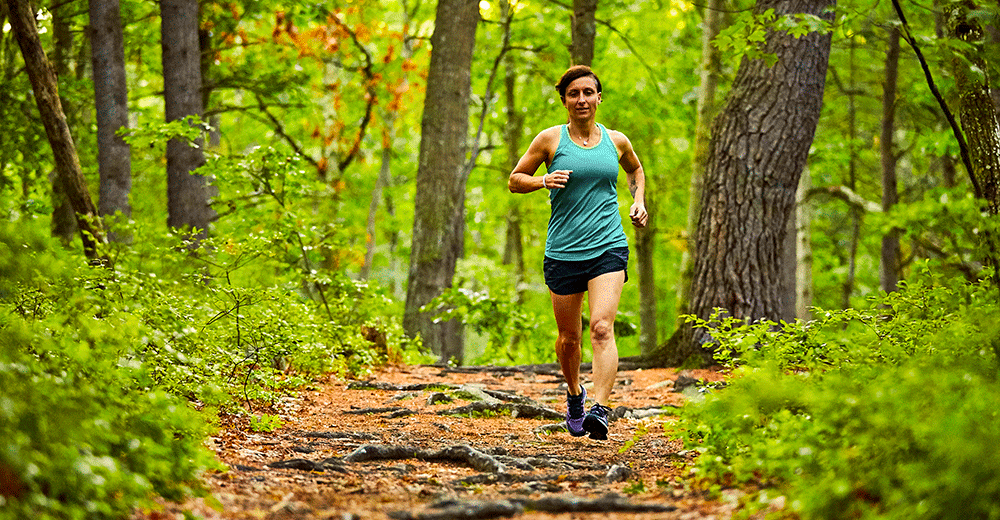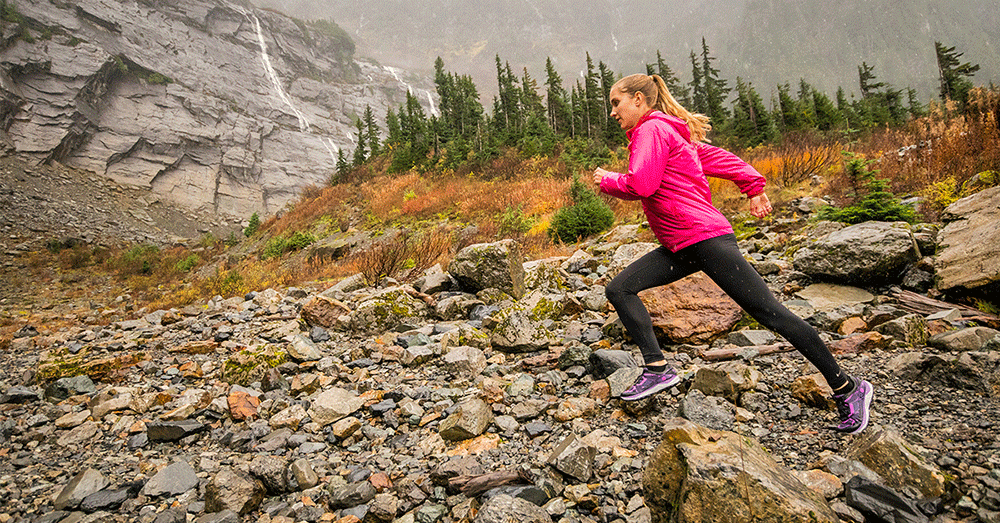
You probably already know that getting off the road is good for your running health. Usually this is attributed to the softer surface creating less impact. More important, however, is that the trail is uneven, requiring you to change your stride with every step. That variability will not only spread stress across different structures in your body, it will also help rewire your movement patterns to create a more robust and efficient stride.
The Value of Variability
The body is wonderfully adaptable, able to recruit different muscles and use different patterns to accomplish the same goal of moving you forward. It is also efficient, selecting patterns that require the least energy given your unique body and its strengths, weaknesses and constraints in the context of each run. Over time, it learns your preferred movement pattern, and those pathways become smoothly worn, entrenched and efficient, like a well-packed ski track. A healthy stride, however, will still vary slightly with each step, spreading stress and adapting to current conditions.
If, however, you run the same way on the same surface at the same pace every day, the brain doesn’t need to pay attention any more. “Over time, if running challenges are insufficiently varying, less and less networked collaborators are required to execute the evermore highly-practiced running pattern,” says Irish performance scientist John Kiely. Neural resources are precious and your brain has other things to worry about. It puts running on auto-pilot, using the same pattern for every step—which is a good way to get hurt.
“Overuse injury is a lack of variability,” says Kiely. “When variability goes down, it’s the same tissues being hit the same way over time with no respite—that’s the recipe for overuse injury.”
The solution is simple: mix things up. “A way to forestall overuse injury and get more running training in safely is to increase variability,” says Kiely. “It can be at different paces, different surfaces, different inclinations.” Which sounds a lot like running trails.

Rewiring Your Stride
Trails can do more than vary stress, however. Another trail running benefit is that it can also improve how you run.
The process of forming those well-packed tracks is called plasticity, the brain’s ability to adapt to new patterns and learn efficient pathways. “Plasticity is a double edge sword,” Kiely explains. “It enables us to conform, but then also encases us in a tomb of constraints. We need to break out of those ruts.”
We create unwanted ruts not only by running in the same pattern too often, but by running with compromised systems such as reduced range of motion, imbalanced muscles and poor posture. Your body will find the most efficient pattern for whatever it is given. Over the miles it becomes accustomed to that pattern, forming a well-worn neural pathway. Even if you change the parameters by doing targeted strength work, stretches and drills, you often remain in the rut you have practiced over the years.
Changing those hardwired patterns requires both variety and focus. “It’s doing something different physically, but it’s also doing challenges that are sufficiently engaging that you have to actually zero in, you have to focus intently on them,” says Kiely. Amidst the barrage of stimuli it faces every minute, your brain has to recognize that, “This is important—if I don’t get it right there is a consequence.”
Which is where trails come in again. Not just any trails: gnarly, technical trails that you have to dance over, where every step is different, and where, if you don’t pay attention, you’re going to have a spectacular tumble. And, ideally, you need to be flying.
Kiely explains the strategy: “There’s a section of broken trail, and I am going to hit that a relatively high speed. It’s a high enough speed that I absolutely have to dial in to what I’m doing and react immediately.”
Granted, you don’t want to come home bruised and broken. “There’s a sweet spot, it’s not reckless,” Kiely admits. “But it’s not in your comfort zone, not something you can do automatically. The key thing: you have to concentrate on it, you have to focus.”
That focus does something magical: it changes the brain chemistry, releasing what Kiely calls, a “cocktail of neuro-modulating chemical catalysts” which enable a re-modeling of learned patterns. “The outcome is certain,” Kiely says. “You have a more robust, more resilient athlete.”

A Few Final Notes
This type of trail running is best done in nimble shoes. Trail shoes tend to either be tanks, designed to stomp down or roll over anything in your path, or sturdy slippers, designed to dance over and around obstacles. The latter are far more conducive to the goals of variability and high-speed focus. Most of the “control” elements of your road shoes are ineffective on soft and variable surfaces anyway.
Given the new strengths and skills you are developing, you’ll want to keep your technical trail experiences rather short to start, and gradually increase them as you feel comfortable. You’ll also only be able to maintain the necessary intense focus for shorter spells, and losing focus on the trail is both dangerous and ineffective at accomplishing the desired re-modeling.
For best results, if your goal is to run better and more naturally, you’ll work to correct some of the compromises that our daily lives put on our bodies, then recalibrate your system with focused trail running. The body notices, for example, that your glutes are pushing back effectively so it doesn’t have to overuse your hamstrings, that your feet have new strength to reduce time on the ground, that your balance is over your hips and it doesn’t have to fire as many muscles to keep you upright—and it creates new, more effective patterns.
But while exercises and drills will do little to improve your stride without shaking up your running, adding variety will benefit you at any time. Any variety is good, the constant, moment-by-moment variety of trail running is exceptional. If there is a fast-track to becoming a better runner, it is hitting the trail.
__________________________
The Whole Athlete is a monthly running series written by Jonathan Beverly and brought to you by Topo Athletic. We aim to deliver advice that serves the whole athlete, from training and recovery to nutrition and psychology.
 Jonathan Beverly is author of Your Best Stride and Run Strong, Stay Hungry. A lifetime runner, his passion is to help others experience the joy of training, competing and being fit and fully alive.
Jonathan Beverly is author of Your Best Stride and Run Strong, Stay Hungry. A lifetime runner, his passion is to help others experience the joy of training, competing and being fit and fully alive.
He served as editor of Running Times from 2000-2015 and has coached runners of all ages and disciplines.
Great entry! It reflects a philosophy I chose to pursue early last year, having spent several months figuring out how to overcome a good dose of plantars fasciitis. I chose to run trails – they’re abundant where I live in Wisconsin – for the exact reasons Jonathan expressed here: the variability of speeds, terrain, incline. The choice was based on a hunch the variability was healthier for my feet, my legs, my body. Nearly 18 months later, there’s no plantars, my dog Newton and I have logged roughly 1300 miles together and I’m heading to my first ever 25k trail run in a week. What’s not to like about trail running, right?! Thanks for a solid article about this!
I wholeheartedly agree with the entire premise of trail running. After a string of injuries incurred from running roads and tracks with not much deviation in stride, I turned to trail running after recovering from yet another calf injury and have never looked back. After running trails almost exclusively for a few years, I gradually added track and roads back into the mix and now run about 60% trails and 40% roads/track for training, with my weekly long run and my monthly target race almost always on a trail, from 5K to marathon. Running trails engages your whole body and mind. It saved and revitalized my running career.